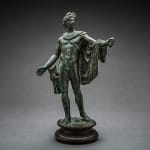Bronze Statue of the Apollo Belvedere, 100 CE - 300 CE
Bronze
height 23.5 cm
height 9 1/4 in
height 9 1/4 in
AM.0127
The Apollo Belvedere is the popular name for the Pythian Apollo, a classical masterwork originally sculpted in bronze by the Greek sculptor Leochares in the 4th century BC. The piece...
The Apollo Belvedere is the popular name for the Pythian Apollo, a classical masterwork originally sculpted in bronze by the Greek sculptor Leochares in the 4th century BC. The piece was greatly admired in the classical world, and was copied at least once by Roman sculptors in the early days of the Roman Empire. However, the piece was then lost following the sacking of Rome, and was not recovered until the 15th century when the marble copy currently in the Vatican was recovered near Rome. The theme is simple. The sculpture depicts the youthful Apollo, who has been called upon to slay the dread sea-monster Python (from which the name of the modern snake is derived). Having just released the arrow from his bow, he stands in heroic pose with his arrow hand by his side, his weight slightly on the right foot, his eyes focused upon his distant quarry, his hair (banded with a strophium) blowing in the breeze and his chlamys (toga) flapping languidly around his muscular frame. Since the rediscovery of the piece, it has become known as perhaps the ultimate classical Greek sculpture, embodying all the heroic values of the divine and the physical perfection of the human. However, there are few copies of the sculpture that predate the Italian Renaissance, which is why the current piece is of some significance. The casting is of good quality, with only minor flaws, and includes an integral base. The patina – which has been partly restored – adds to the gravitas of the sculpture. The date of the figure makes it a very early representation of a work which later fuelled the European Renaissance, making this an attractive, desirable and important masterwork of Roman art.



